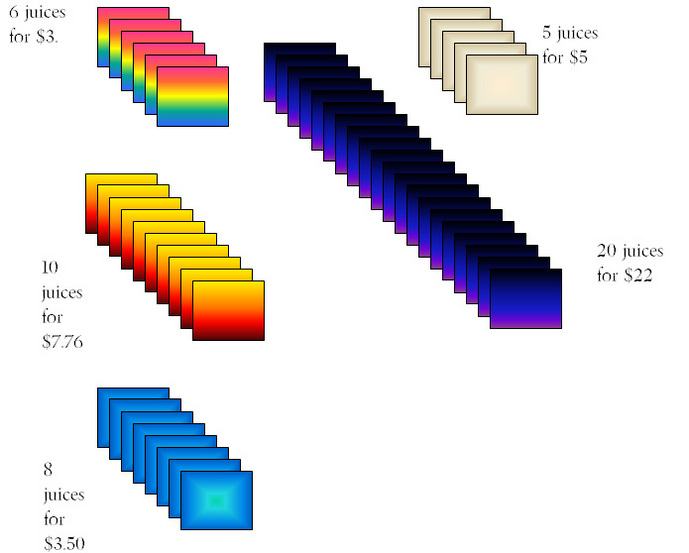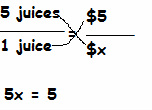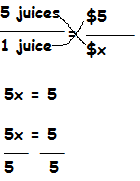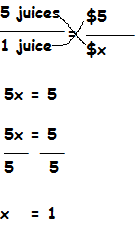Unit Rate
Overview: You will learn how to find the unit rate and cross multiply.
Definition: A comparison of two measurements in which one of the terms has a value of one.
Example: There are 5 boxes of juices. The first box has 5 juices for $5. The second box has 6 juices for $3. The third box has 10 juices for $7.76. The fourth box has 8 juices for $3.50. The fifth box has 20 juices for $22. Which box has the smallest unit price?
__________________________________________________________________________________________________________________________________________
How to solve the problem
Step 1: Look at the problems again and find the important numbers ( 5 juices for $5, 6 juices for $3, 10 juices for $7.76, 8 juices for $3.50, and 20 juices for $22) by highlighting them in the problem.
There are 5 boxes of juices. The first box has 5 juices for $5. The second box has 6 juices for $3. The third box has 10 juices for $7.76. The fourth box has 8 juices for $3.50. The fifth box has 20 juices for $22. Which box has the smallest unit price?
Step 2: Draw out your equation. You will cross multiply.
There are 5 boxes of juices. The first box has 5 juices for $5. The second box has 6 juices for $3. The third box has 10 juices for $7.76. The fourth box has 8 juices for $3.50. The fifth box has 20 juices for $22. Which box has the smallest unit price?
Step 2: Draw out your equation. You will cross multiply.
Step 3: Do the same formula with every set of numbers; find the unit rate for all the numbers [( 5 juices for $ 5 =$1 per juice ) ( 6 juices for $3 = $0.50 per juice) ( 10 juices for $7.76 = $0.78 per juice) ( 8 juices for $3.50 = $0.44 per juice) ( 20 juices for $22 = $ 1.10 per juice)]
Step 4: Find the answer to the question. Look at the smallest number. The smallest numbers are 8 juices for $3.50 = 1 juice for $0.44.
Step 5: Write the answer. The box that has the smallest unit price is the fourth box; 8 juices for $3.50 =$0.44 per juice.
Step 4: Find the answer to the question. Look at the smallest number. The smallest numbers are 8 juices for $3.50 = 1 juice for $0.44.
Step 5: Write the answer. The box that has the smallest unit price is the fourth box; 8 juices for $3.50 =$0.44 per juice.
For more information on this subject go to http://www.amathsdictionaryforkids.com/dictionary.html





